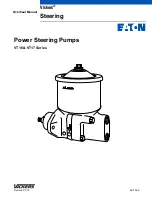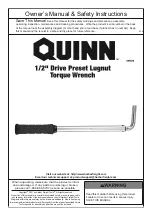
8
F. Operating Instructions
Normally these pumps require no manual priming. It is
essential, however, that after starting a minimum drive speed
of 400 rpm be maintained until the pump picks up its prime.
Failure to observe this precaution can result in scoring and
possible seizure of the pump due to a lack of oil for
lubrication.
CAUTION
Do not use hydraulic brake fluid. Use only high
grade hydraulic oil of the viscosities recommended
in paragraph D on Hydraulic Fluid Recommenda-
tions. Do not use fire resistant fluids in Vickers’
products without consulting Vickers’ application
engineering personnel. O-Rings, seals and pack-
ings which are not compatible with petroleum base
fluids are not compatible with synthetic type fluids.
Section V - Service Inspection and Maintenance
A. Service Tools
The only special service tool required is a shaft oil seal
driver. The driver is used to insure that the seal is not
damaged during installation. A piece of tubular round stock
should be machined so that the outside diameter is 1-5/8
inches and inside diameter is 1 inch. The tool must be at
least 2-1/2 inches long and the ends must be squared.
B. Inspection
Periodic inspection of oil condition and pressure connections
will ave time consuming breakdowns and unnecessary parts
replacement.
1. All hydraulic connections must be tight. A loose con-
nection in pressure lines will allow fluid to escape. In suction
and return lines, loose connections will permit air in the
pump, resulting in noisy and erratic operation.
2. System filters and reservoir should be checked for
foreign particles. If contamination is found, the system
should be drained.
a. The reservoir must be cleaned thoroughly before
refilling. All lint particles must be removed to avoid possible
clogging of system filters.
b. New oil of the proper specification, poured through
a micron filter or a 200 mesh screened funnel, should be
used to refill the reservoir.
C. Maintenance
1. All openings in the circuit must be properly capped if a
unit is removed for service. Units removed also should be
capped or plugged to prevent the entry of dirt or other for-
eign matter.
2. These pumps require no adjustments other than main-
taining correct shaft alignment.
D. Lubrication
Lubrication of these pumps is automatically accomplished by
the hydraulic fluid.
E. Trouble Shooting
Table 4 lists the pump difficulties most commonly encountered
and indicates the probable causes and remedies. It must be
remembered that many apparent pump failures can actually
be other units in the system. Improper operation is best
diagnosed with adequate testing equipment and a thorough
understanding of the complete hydraulic system.
F. Spare Parts
Only genuine parts manufactured or sold by Vickers
Incorporated should be used.





























